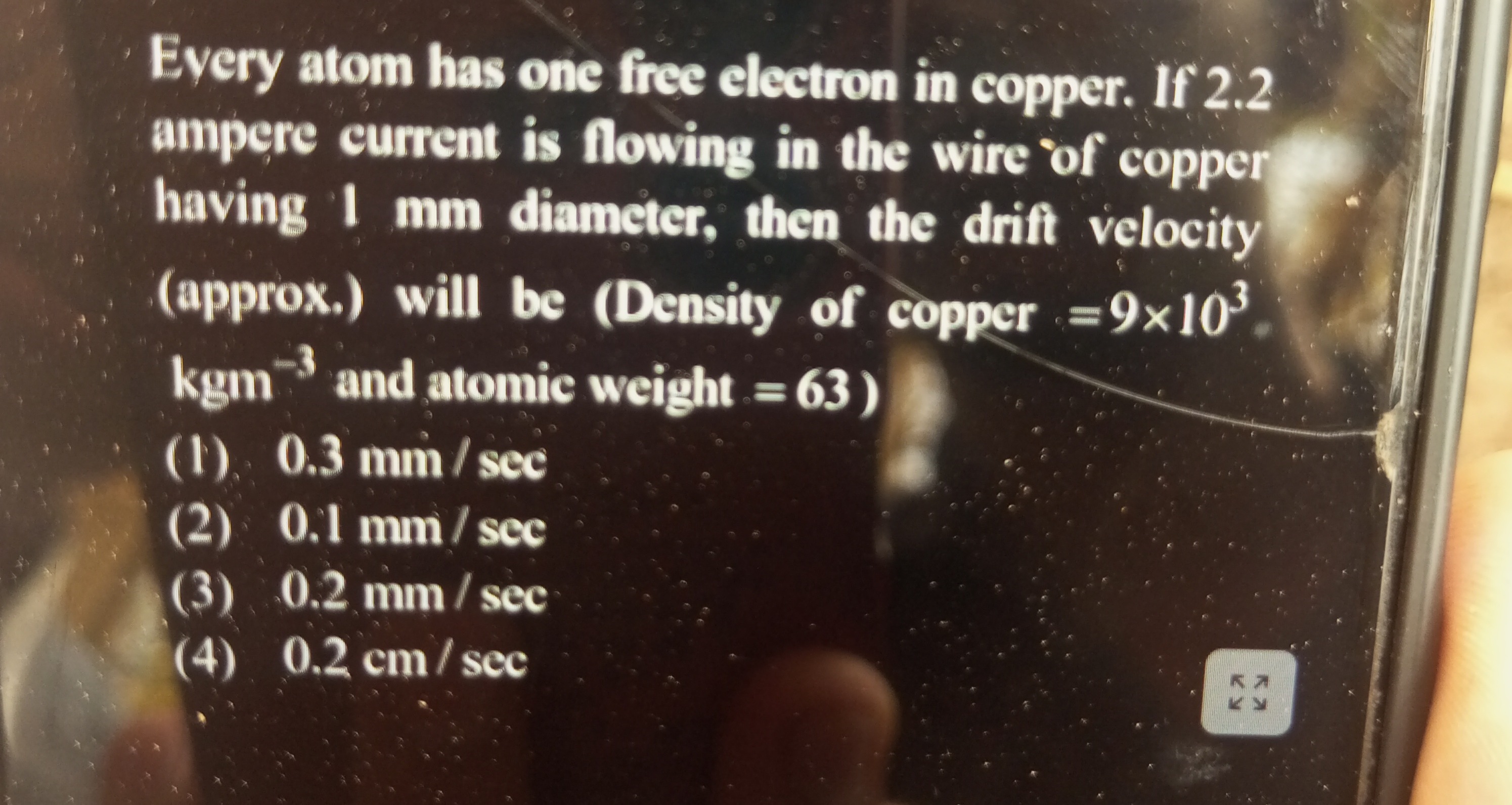Question
Question: Every atom has one free electron in copper. If 2.2 ampere current is flowing in the wire of copper h...
Every atom has one free electron in copper. If 2.2 ampere current is flowing in the wire of copper having 1 mm diameter, then the drift velocity (approx.) will be (Density of copper = 9×103 kgm−3 and atomic weight = 63)

0.3 mm/sec
0.1 mm/sec
0.2 mm/sec
0.2 cm/sec
0.2 mm/sec
Solution
The drift velocity vd of electrons in a conductor is given by the formula:
vd=neAI
where:
I is the current flowing through the wire.
n is the number density of free electrons (number of free electrons per unit volume).
e is the elementary charge (1.6×10−19 C).
A is the cross-sectional area of the wire.
First, we need to calculate the number density of free electrons, n.
The density of copper is ρ=9×103 kg/m3.
The atomic weight of copper is 63. This means the molar mass of copper is M=63×10−3 kg/mol.
Avogadro's number is NA=6.022×1023 atoms/mol.
The number density of copper atoms is given by the number of atoms per mole divided by the volume per mole. The volume per mole is the molar mass divided by the density.
Volume per mole =ρM=9×103 kg/m363×10−3 kg/mol=7×10−6 m3/mol.
The number density of copper atoms is Volume per moleNA=7×10−6 m3/mol6.022×1023 atoms/mol=76.022×1029 atoms/m3.
Since every atom of copper has one free electron, the number density of free electrons is n=76.022×1029 m−3≈0.8603×1029 m−3.
Next, we calculate the cross-sectional area of the wire, A.
The diameter of the wire is d=1 mm =1×10−3 m.
The radius is r=d/2=0.5 mm =0.5×10−3 m.
The area is A=πr2=π(0.5×10−3)2=π(0.25×10−6) m2.
Using π≈3.14159, A≈0.7854×10−6 m2.
The current flowing is I=2.2 A.
The charge of an electron is e=1.6×10−19 C.
Now, we can calculate the drift velocity:
vd=neAI=(0.8603×1029 m−3)×(1.6×10−19 C)×(0.7854×10−6 m2)2.2
vd=(0.8603×1.6×0.7854)×1029−19−62.2 m/s
vd=(0.8603×1.6×0.7854)×1042.2 m/s
Calculate the product in the denominator: 0.8603×1.6×0.7854≈1.080.
vd≈1.080×1042.2 m/s≈2.037×10−4 m/s.
We need to convert the drift velocity to mm/sec.
1 m=1000 mm.
vd≈2.037×10−4 m/s×1 m1000 mm=2.037×10−4×103 mm/sec=2.037×10−1 mm/sec=0.2037 mm/sec.
Comparing this value with the given options, the calculated value 0.2037 mm/sec is closest to 0.2 mm/sec.
